Journal
of Non-lethal Combatives, Apr 2001
The Secrets of Jujitsu, A Complete Course in Self
Defense, Book VII

By Captain Allan Corstorphin Smith, U.S.A.
Winner of the Black Belt, Japan, 1916. Instructor of Hand-to-Hand Fighting,
THE INFANTRY SCHOOL, Camp Benning, Columbus, Georgia and at United States
Training Camps and Cantonments, 1917 and 1918.
In Seven Books.
BOOK SEVEN
STAHARA PUBLISHING COMPANY
Columbus, Georgia, 1920.

***
This electronic version is copyright EJMAS © 2001. All rights
reserved.
Contributed by Thomas J. Militello, a 15-year member of Astoria,
New York's non-profit Horangi Taekwondo Dojang, which is headed by James
Robison.
Lesson 46. Knee smash on nose.
Lesson 47. Front strangle hold. Chin hold.
Lesson 48. Secret jujitsu front strangle hold.
Lesson 49. Throwing man from behind. Foot on knee.
| |
Name of Partner |
Date Commenced |
Lesson 46 |
Lesson 47 |
Lesson 48 |
Lesson 49 |
| 1. |
|
|
|
|
|
|
| 2. |
|
|
|
|
|
|
| 3. |
|
|
|
|
|
|
| 4. |
|
|
|
|
|
|
| 5. |
|
|
|
|
|
|
| 6. |
|
|
|
|
|
|
| 7. |
|
|
|
|
|
|
| 8. |
|
|
|
|
|
|
| 9. |
|
|
|
|
|
|
| 10. |
|
|
|
|
|
|
Lesson 50. Throwing man from behind. Knee on back.
Lesson 51. Rear strangle (Hadakajime).
| |
Name of Partner |
Date Commenced |
Lesson 50 |
Lesson 51 |
|
|
| 1. |
|
|
|
|
|
|
| 2. |
|
|
|
|
|
|
| 3. |
|
|
|
|
|
|
| 4. |
|
|
|
|
|
|
| 5. |
|
|
|
|
|
|
| 6. |
|
|
|
|
|
|
| 7. |
|
|
|
|
|
|
| 8. |
|
|
|
|
|
|
| 9. |
|
|
|
|
|
|
| 10. |
|
|
|
|
|
|
Make a check mark against each trick each day you practice it.
KNEE SMASH ON NOSE
Assailant comes at you with his head down, as if to seize you around
the legs.
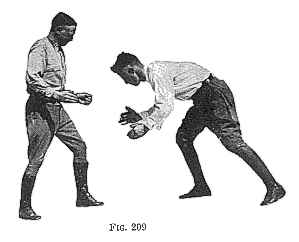
Time his rush carefully. Place one or both hands on the back of his
head. Bring it down violently on your knee, which you raise in the same
moment.
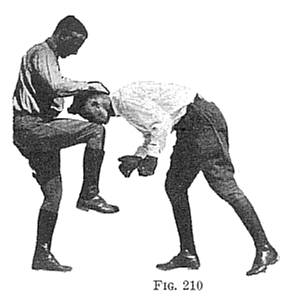
Make your effort from the Stahara, thus getting all the force of your
body into the blow. In practicing, stop the knee three inches from the
Assailant’s nose.
FRONT STRANGLE HOLD
The strangle hold usually taught is to pass your right arm under his
neck with the palm downwards. (There is also a chin hold wherein you bring
your wrist against opponent’s chin. Clasp your right hand with your left.
Twist his neck by lowering your right elbow and raising your right hand.)
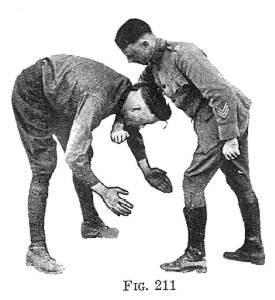
Place your right hand on your left wrist and your left hand on his shoulder.
If you are strong you will have no difficulty in making opponent quit by
this hold; or even if you are not so strong and get it on by surprise.
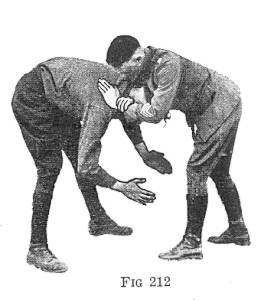
If you are up against a man with a "bull-neck," however, your efforts
will be in vain as his neck is stronger than your arms. Practice it a few
times to augment your experience, then discard it for the jujitsu secret
strangle.
SECRET FRONT STRANGLE HOLD
Place your right forearm under opponent’s neck with the sharp wrist-bone
against his windpipe. Keep your wrist straight.
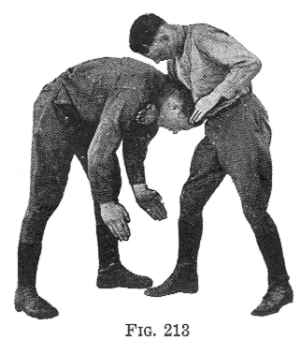
Place the palm of your right hand on the back of tour left, with your
fingers gripping your palm. Hold his neck tightly between your arms and
your body (under your armpit).
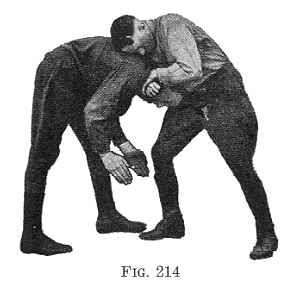
In this position you can easily strangle him by tightening the pressure
of your wrist on his windpipe. This hold is known only to a limited circle.
It is not taught in any standard Japanese jujitsu book.
Hold his neck rigidly against your body. Bring your Stahara forward
and upward, thus increasing the pressure of your wrist, until his neck
is dislocated.
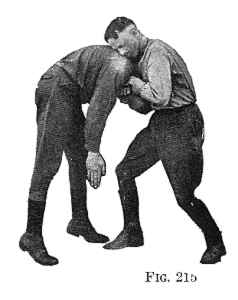
The strength of the weakest man’s Stahara is stronger than the strongest
man’s neck and you can kill a man with this grip instantaneously.
This is a super-secret method of doing a secret trick. Do it slowly.
You can practice this hold on one another with the utmost safety and with
absolutely no fear of injuries or accidents. These secret jujitsu holds
are like an immense steam hammer whose power can be so controlled that
it will perform the most delicate operations. In matches where this has
been used to defeat the opponent, I have never seen anyone suffer even
momentary discomfort after the hold was released.
You will find it difficult at first to coordinate your arm strength
and your Stahara strength. When you first use Stahara strength, your arms
will relax, but practice until you get the proper coordination.
To obtain an opponent who will allow you to experiment on him, you must
first practice according to the rules laid down in "How to Make an Opponent
Quit" in Book One.
SECRET STRANGLE HOLD – continued
You can pull opponent into the strangle hold by placing one hand on
the back of his neck and pulling him forward off balance. By a little
practice you will be able to utilize his forward momentum. If you try this
when he has no forward momentum, it will not succeed.
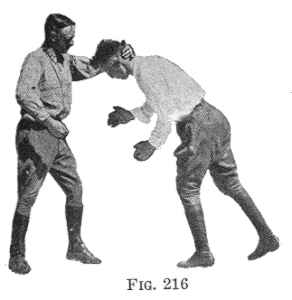
Pull his head under your armpit.
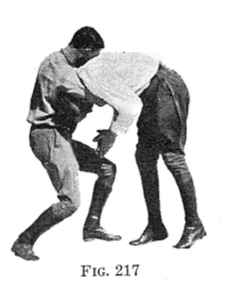
Opportunities for this hold occur most frequently when opponent is trying
for your legs.
There are three reasons why this hold is so much deadlier than the ordinary
front strangle hold.
-
The sharp edge of your wrist will choke him a tenth of the time that the
flat side would.
-
You use the strength of the Stahara, not the strength of arms only, in
choking him.
-
You unbalance him onto his tiptoes, thus weakening his powers of resistance.
HOW TO THROW A MAN FROM BEHIND
In practicing the trick on the next page, a beginner usually makes the
mistake of pulling the opponent back so clumsily that he loses his own
balance. To do so, keep limber all over, with your strength and balance
in the Stahara.
The first point to aim at in practice is to keep your own balance. To
do so, keep limber all over with your strength and balance in the Stahara.
The second point is: do not pull him by main strength, topple him
back.
The third point in your practice is to steal gently up to your opponent,
place your hands and foot on him simultaneously, and have him on the ground
the next instant.
Take the position of each figure in this trick and compare your own
position with the illustrations.
Place him on the ground so gently that he is hardly aware anything has
happened, then gradually work up speed. By combining gentleness and speed,
you will gradually acquire the action of the tiger.
HOW TO THROW A MAN FROM BEHIND – ii
Place your hands on opponent’s shoulders. Simultaneously place your
right instep behind his right knee. (In a real emergency you may use your
toe.)
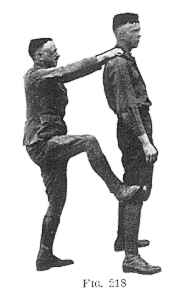
With the foot, knock his knee forward. Simultaneously pull his shoulders
back.
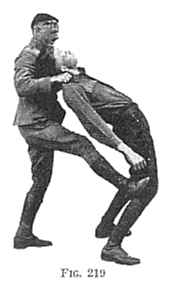
Let his back come against your chest. Pass your arms over his shoulders
and through his armpits.
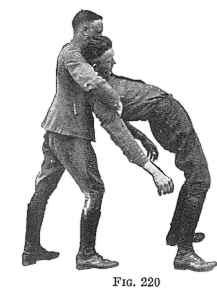
Step back, and lower him gently to the ground.
With your right knee, support his right shoulder. Bend the right knee.
Extend left leg straight behind you, foot flat on the ground. The knee
may be bent a little.
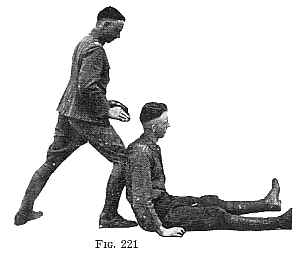
Keep your body well balanced, with your strength in the Stahara. From
this position, start your practice of the strangle hold and death lock.
IMPROVED METHOD OF THROWING A MAN FROM BEHIND
Place your hands on opponent’s shoulders and simultaneously place your
knee on his backbone just below his belt. Do not grasp his clothing, it
is just a waste of time.
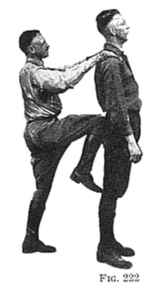
Pull his shoulders back, and drive your knee forward simultaneously.
This is done with a forward movement of the Stahara.
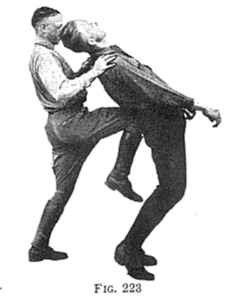
The right foot is instantly returned to the ground. Opponent’s body
flies forward to this position.
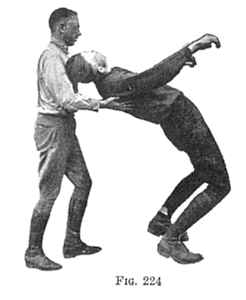
If unsupported, he would crash to the ground with sufficient force to
be knocked out.
Practice this trick in the same manner as the previous trick, by passing
your hands through his armpits and seating him on the ground in front of
you. In war you would drive your knee against his spine with sufficient
force to paralyze him. In practice, place your knee on his back,
gently, then flip his hips forward.
You will soon do these two movements without a pause, and so swiftly
that an onlooker would think you were kicking your opponent, yet the opponent
would hardly feel your knee. By adopting this method of practice you will
be able to continue till you can do it like a flash of lightning.
If you start too roughly at first with one another, you will never continue
your practice to the point of proficiency.
ADVANCED PRACTICE IN THROWING MAN FROM BEHIND
The advantage of the improved method of throwing a man instead of the
first method of knocking his leg away is hat if you knock away, say, his
right leg, and he happens to have his weight on his left leg, he will not
fall. By knocking his hips from under him, however, there is no chance
of failure.
This trick is not only a deadly method of attack in itself, but it is
the best preparatory exercise for the Standing Death Lock, as it gives
you the correct knack of unbalancing a man. As you place hands and knee
on him, keep your balance in your Stahara, otherwise you will be leaning
on him for support and your legs and arms will not coordinate and will
not throw him with their maximum strength. After a little practice you
will be able to steal up, lay your hands and knee on him simultaneously,
and have him on the ground before he realizes you have touched him, and
so expertly that you jar neither his spine, his neck, nor his seat when
he reaches he ground. This of course requires your initial practice to
be very slow and careful.
REAR STRANGLE
When an opponent is on the ground with his back towards you, step up
close with your right foot. Place your right knee against his shoulder.
Kneel on your left knee.
Place your elbow on his shoulder with the forearm straight out in front.
Bring your right forearm in front of his throat, the sharp edge of the
wrist-bone against his windpipe.
Place the fingers of your right hand on the elbow of your left hand.
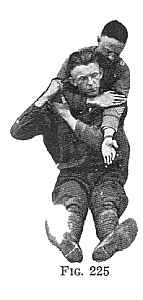
Bring the palm of your left hand behind opponent’s head. Strangle him
by pressing his head forward with your left hand and pressing his windpipe
with your right wrist.
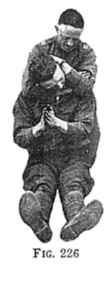
Go slowly and release him the instant he signals defeat.
STRANGLE HOLDS IN A JUJITSU MATCH
In a jujitsu match, when an opportunity offers, the strangle hold is
applied like a flash of lightning. The opponent makes the signal of defeat,
and the match is decided. Quick as has been the operation, no injury or
pain has resulted to the vanquished man.
A jujitsu man who applied a hold so roughly and clumsily as to damage
his opponent would be so ashamed of himself that he would not show his
face in the wrestling hall for months to come. Such an incident, however,
does not occur. Before a jujitsu man has worked his way up to the ranks
of the third-class exponents, he has acquired a temperance, a control of
his movements, that makes such an occurrence unthinkable.
Although there is no limit to the deadly nature of the holds used in
a jujitsu match, there is never an accident on that account. I have trained
large numbers of men in the effective use of the Death Lock, and by this
system in a few lessons, they, too, acquire a temperance, and are able
to use this hold with safety to themselves and their opponents.
The rear strangle is one of the four methods used in jujitsu matches
of strangling a man from the rear, all of them equally effective and interesting.
They achieve their object of making the opponent quit either by pressure
on his windpipe, on the nerves and blood vessels of his neck, or on his
spine. You are not taught these other methods in this course, for the simple
reason that the Death Lock supplants them all. A complete course of self-defense
should teach you not only the best tricks to use, but why you should use
them, and we give you this rear strangle so that you may compare it with
the Death Lock.
LESSON 52
THE SECRET JAPANESE DEATH LOCK
The most effective hold in existence.
Superior to the ancient secret holds of Greece and Rome.
Known to but few Japanese and never before published in any book, Japanese
or foreign.
| |
Name of Partner |
Date Commenced |
The Death Lock |
| 1. |
|
|
|
| 2. |
|
|
|
| 3. |
|
|
|
| 4. |
|
|
|
| 5. |
|
|
|
| 6. |
|
|
|
| 7. |
|
|
|
| 8. |
|
|
|
| 9. |
|
|
|
| 10. |
|
|
|
Make a check mark against each lesson each day you practice it
THE SECRET JAPANESE DEATH LOCK
Set your opponent on the floor with his back to you. Place your right
knee against his right shoulder with your left leg straight behind and
your balance and strength in the Stahara.
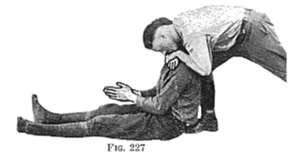
Place your right cheek against his left cheek.
Place your right forearm in front of his neck, with the sharp bone against
his windpipe.
Place the palm of your left hand on the back of your right, and clasp
tightly.
Keep the weight of your body on the back of his head or neck, and choke
him by pressure of your wrist-bone on his windpipe.
Be cautious and slow, and release the instant he claps.
THE DEATH LOCK – FRONT VIEW
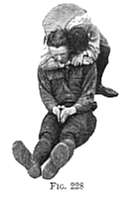
Study of these two photos will teach you more than countless demonstrations
or explanations. The hold can be taken so quickly and effectively that
the opponent has quit and been released before the observer has had time
to notice it.
Again, if you did happen to get this hold on a man, you would try to
choke him with your arms, and as you have less leverage than the previous
rear strangle, you would conclude that the former was the better trick.
This explains how the few people who knew this trick were able to keep
its secret to themselves. Now, however, by these photos and instructions
anyone may discover for themselves how to apply the weight of the whole
body against opponent’s neck.
THE HISTORY OF THE DEATH LOCK
I had studied jujitsu six or seven years before I knew that such a hold
existed. I had retained one of the cleverest exponents of jujitsu, who
was professor at one of the large military stations, and he made a long
journey three times weekly to instruct me at my private wrestling school
in Yokohama. Although I was in the ranks of the "first-class" men when
I started with him, he could at first make me quit every few seconds, but
in about a year I worked this down until the average was three victories
for him in five minutes, and he had to exert himself to defeat me.
He was a slow looking man, but he could apply locks and holds quicker
than the proverbial greased lightning. The speed of his movements was accentuated
by the fact that he maneuvered me into "walking into" these holds, half
of his speed coming from my own efforts. I was especially amazed at the
speed with which he used to choke me from the rear, and thought it was
the ordinary rear strangle. But gradually my suspicions were aroused that
he had another hold. None of my other teachers ever tried such a hold on
me, and I never saw it used in matches or practices in the large schools.
Asked point blank what method he was using, he would very conscientiously
demonstrate the rear strangle, stoutly denying that he ever used anything
else, or that any other hold existed, except, as he hinted, in my vivid
and suspicious imagination.
One day the chance came for which I was waiting. I left an opening for
the rear strangle and quick as a flash he applied it. Simultaneously I
placed my right hand on top of my head, and my left hand on my left shoulder,
and discovered of course that he was not using the ordinary rear strangle.
When I recovered consciousness (I could not make the signal of defeat
as my hands were busy investigating his grip), I told the professor that
I had proved that he had another grip which he was hiding from me. My kind
instructor thereupon thought that such perseverance and merit should be
rewarded suitably, which he thereupon did, by imparting the secret Death
Lock to me.
Lesson 53. Escape from Death Lock.
Lesson 54. Dislocation Death Lock – from which there is no escape.
Lesson 55. Scissors Death Lock.
Lesson 56. Scissors Death Lock on a man crawling ahead of you.
| |
Name of Partner |
Date Commenced |
Lesson 53 |
Lesson 54 |
Lesson 55 |
Lesson 56 |
| 1. |
|
|
|
|
|
|
| 2. |
|
|
|
|
|
|
| 3. |
|
|
|
|
|
|
| 4. |
|
|
|
|
|
|
| 5. |
|
|
|
|
|
|
| 6. |
|
|
|
|
|
|
| 7. |
|
|
|
|
|
|
| 8. |
|
|
|
|
|
|
| 9. |
|
|
|
|
|
|
| 10. |
|
|
|
|
|
|
Lesson 57. Preliminary practice in Standing Death Lock.
Lesson 58. Special exercise in pulling a man back.
Lesson 59. The Standing Death Lock.
| |
Name of Partner |
Date Commenced |
Lesson 57 |
Lesson 58 |
Lesson 59 |
|
| 1. |
|
|
|
|
|
|
| 2. |
|
|
|
|
|
|
| 3. |
|
|
|
|
|
|
| 4. |
|
|
|
|
|
|
| 5. |
|
|
|
|
|
|
| 6. |
|
|
|
|
|
|
| 7. |
|
|
|
|
|
|
| 8. |
|
|
|
|
|
|
| 9. |
|
|
|
|
|
|
| 10. |
|
|
|
|
|
|
Make a check mark against each lesson each day you practice it.
THE ESCAPE
Seize your opponent’s right sleeve above the elbow with both hands.
Tug his elbow forward. At the same time , turn your chin into his right
elbow.
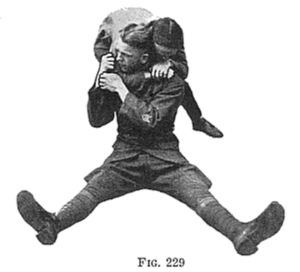
Pull him down over your right shoulder.
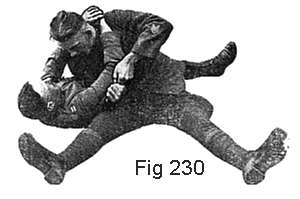
If the escape be executed before Assailant gets his full pressure on
your neck, it is easy to get away.
NOTE ON THE IMPORANCE OF THE STAHARA
Take the Death Lock on opponent seated, putting strength into the arms
only, and standing with the Stahara limp and relaxed. Let opponent execute
the escape and note how easily you go over his shoulder.
Again take the Death Lock, this time with balance in your Stahara. Again
let him try to escape, and note how easily you can frustrate his attempt.
THE DEATH LOCK – DISLOCATION
Take the Death Lock position.
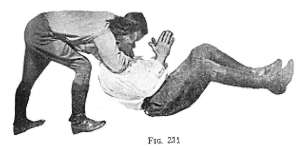
With the weight of your body, press opponent’s head forward. At the
same time step back six inches with the right foot, pulling his neck back
with your right forearm By this combination of strangulation and dislocation,
the weakest man can make the strongest man quit, or, in case of warfare,
kill him.
Let your first experiments with this deadly hold be cautious. Better
do it slowly and gently until you gradually get it, than do it energetically,
and succeed the first time, but so roughly that your opponent declines
to let you do it any more.
If you do it gently, not only is there no danger, but no discomfort.
From this hold, there is no escape.
THE SECRET SCISSORS DEATH LOCK
Squat down behind opponent and take the Death Lock hold exactly as in
figure 232. Practice this formally until you are proficient. Afterwards
the lock may be used in various combinations.
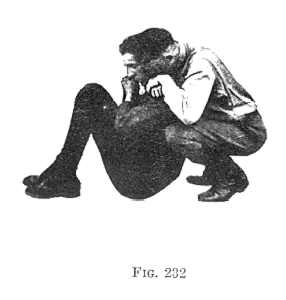
Let opponent try to escape by straightening his knees and pushing you
over backwards, slowly. Keep tight hold on his neck. (The knowledge of
this trick is not very general amongst the jujitsu fraternity. The possession
of this secret gives the lucky man an immense advantage in matches.)
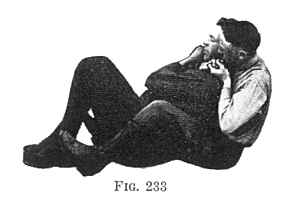
Let him roll you right over onto your back. Wrap your legs around his
thighs. Choke him by pressure of the sharp wrist-bone on his throat.

You can make a man unconscious instantaneously by this trick.
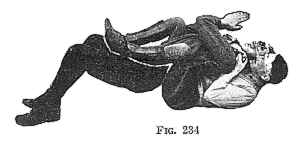
The inside wrinkle to this trick, which makes it doubly effective, is
to raise your Stahara. This extends his body, "unbalances him," and weakens
his power of resistance.
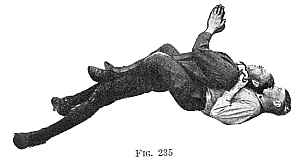
Make sure that your wrestling partner understands the signal of defeat,
and release him the instant he quits. There is no danger in practice, only
do it slowly at first.
SCISSORS DEATH LOCK ON A MAN WHO IS CRAWLING AHEAD OF YOU
If you are on patrol duty and see an enemy ahead of you whom you must
"get" without letting him give the alarm, steal up silently and get him
unawares.
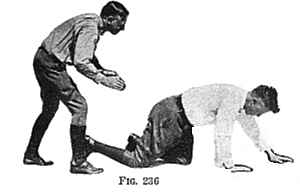
Get your right wrist around his neck, as already learnt in the ordinary
Death Lock. Clasp your right hand with your left. Press the right side
of your face against the left side of his. This grip will silence him.
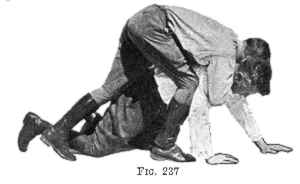
Roll either to the right or the left, pulling him after you. Wrap your
legs around his thighs to prevent his escaping, and choke him with the
pressure of the sharp wrist-bone on his windpipe.
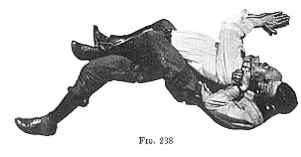
You get an additional leverage and weaken his resistance by raising
your Stahara.
This trick may be used with great effect on a burglar, if such a gentleman
pay you a professional visit and you catch him unawares.
Practice on grass or a carpet, and do it slowly and carefully.
This is the first time that a description of this deadly hold has been
reduced to writing, or photographed.
PRELIMINARY PRACTICE IN THE STANDING DEATH LOCK
Simultaneously place your knee on opponent’s back, and your hands on
his shoulders, and throw him into position of figure 240. Before you try
this, practice lessons shown at figures 222-224, and figure 227. This method
would be useful against a very tall opponent whose neck you could not reach
with your wrist. But for all ordinary opponents, the method shown in figures
242-245 is safer and quicker.
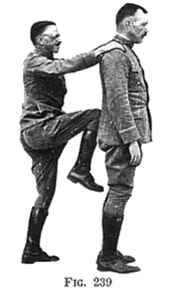
By the time his head is on your shoulder, you have secured the Death
Lock and he is giving the signal of defeat.
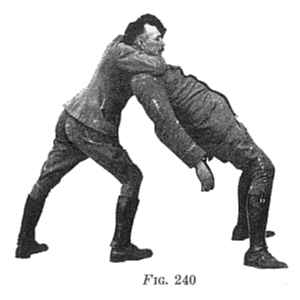
A summary method of dispatching him would be to step back, bringing
his seat smartly to the ground, when the impact will break his neck. Ability
to keep your balance is the first essential in this trick, both for safety
in practice and efficiency in execution.
SPECIAL EXERCISE IN PULLING A MAN BACK
To become expert in the Standing Death Lock, pass your hand in front
of opponent’s neck, as in figure 243, and pull him back into position of
figure 241.
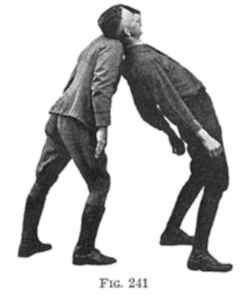
Drop your hands to your side. Let the back of opponent’s neck rest on
top of your shoulder (the Trapezius muscle). Do this, not by strength,
but by unbalancing him. Guard against the sharp edge of your wrist choking
him as you pull back. Be gentle.
Practice it with your opponent standing still until you find the correct
angle at which to unbalance him, at right angles to his line of support.
(See Book Five.) Soon you will unbalance him more quickly than he can step
back.
Some men are never able to do the Death Lock because they rest the back
of opponent’s head or neck on their chest, thus exerting pressure in the
wrong place. Some of my biggest and strongest pupils have been the slowest
and most clumsy because they persisted in doing it with the strength of
their arms. They could not use their bodies aright. This special exercise
soon corrected that fault.
THE STANDING DEATH LOCK
Steal up behind opponent so softly that he does not hear you. Do not
try this trick until you have mastered previous lessons. This trick is
perfectly safe if you first master the preliminary exercises. But if you
try this trick immediately on getting the book without previous training,
I shall not be responsible for any injuries.
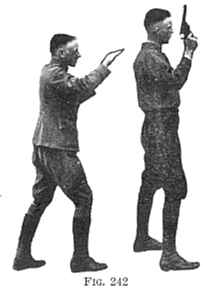
Pass your right wrist in front of his neck, with the wrist straight,
and your sharp wrist-bone against his windpipe.
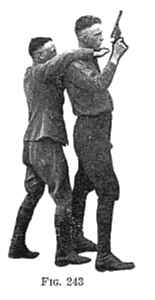
In practice be gentle. In actual attack knock him out, or at least render
him speechless, by a sharp blow on the windpipe with the wrist.
Pull him back into position of figure 244, with the back of his head
wresting between your neck and shoulder, and strangle him.
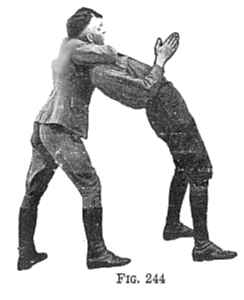
Practice it slowly.
By adding the process of dislocation to that of strangulation (that
is, by getting him into position of figure 245), you make the hold twice
as effective.
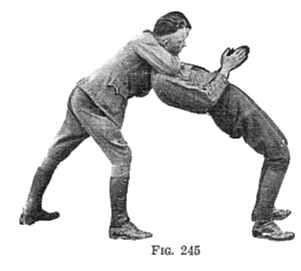
Practice the lesson of the Death Lock seated before you try it standing
up.
HOW TO TEST YOUR EFFICIENCY IN THE DEATH LOCK
Have your partner stand with his back to you, six feet away. Tell him
to call "Help" as soon as he feels you touch him. Steal up behind him and
get him in the Death Lock before he can call out.
You are handicapped by the fact that he is expecting your attack, but
even so, you will be able to get him
Remember that in an actual attack you would not take him gently, but
would strike him so smartly on the neck hat he would be incapable of uttering
a sound. Do not try this test until you have practiced for two weeks according
to instructions. You will then be able to apply it without hurting your
partner. You have all the rest of your life to practice in, so why run
the risk of injuring a friend by trying the test without due preparation?
NEVER FOOL WITH THE DEATH LOCK
The Death Lock is too sacred and serious a thing to utilize in horseplay.
A jujitsu man practices hard for about an hour a day, and that is enough
for him. When off the mat, he leaves it alone and thinks it beneath his
dignity to fool around with dangerous tricks where there is a chance of
accident from a slippery floor or a sharp corner. Avoid practical jokes
around the office, or the parlor, or any other place where people are not
expecting rough play. You will make yourself unpopular. You may bring jujitsu
into discredit. And you may cause injuries.
Take all the practice you want at the right time, and with people who
are similarly inclined.
THE SCOPE OF THIS COURSE
Although jujitsu matches have been occasionally mentioned, none of the
tricks used in this course, with the exception of the strangle holds in
Book Seven, could be used in a jujitsu match.
This course has taught the simplest and most effective ways of dealing
with an armed or unarmed aggressor, whose intentions are to kill, maim,
or rob. In addition, it has taught many tricks by which you may take prisoner,
or disarm, an enemy without going the length of injuring or killing.
It has introduced you to this study by the use of movements with which
you are acquainted, or which at least are simple. It uses the familiar
as a stepping stone to the unfamiliar.
In this course each trick is practiced separately and formally, it being
arranged beforehand who will act as aggressor.
My Japanese friends may criticize this course for containing matters
extraneous to jujitsu (particularly the theory of Stahara), which were
never taught me in Japan, but I believe this system will give quicker results
in learning the art than any yet advised.
THE SCOPE OF THE NEXT COURSE
The next course teaches specifically the throws of jujitsu. It will
teach you how to fall. It will teach the hip throw, by means of which a
little woman can soon learn to lift and throw a heavy man. It will teach
you the trips (there are seven different trips), the swiftest and most
effective part of jujitsu wrestling. It will teach the Stomach Throw, wherein
you go down on your own back, place the sole of one foot on opponent’s
stomach, and throw him over your head onto the floor behind you. It will
teach the groundwork of jujitsu, the collar-chokes and arm-locks used in
matches, which will bring victory whether you or he are on your back. The
second course introduces you to competitive jujitsu, wherein either party
may attack as he pleases with any of the tricks allowed in Stahara wrestling.
VALEDICTION
Student of this course, whosoever ye be, of whatever country, creed,
or color, you are under an obligation to humanity at large, as well as
to me, the humble medium that conveyed the knowledge, never to use the
power you have acquired in a dishonest or dishonorable cause, or for a
selfish purpose.
Let these exercises train not only your bodies, but also your chivalrous
instincts, your sense of honor.
Though they give you the ability of a knight of old to rely on and use
your own good right arm, they will fall short of their purpose if they
fail equally to train you in the ethics of the knightly code – to battle
for the right, and to defend the oppressed.
For the enemy of society at large, the Apache [e.g., an urban thug],
the cutthroat, the assassin, we have in reserve tactics which will help
to level the odds, since he is armed, and we are not.
In an unhappy struggle with those from whose opinions we differ, but
who are actuated by motives as honorable as our own, defeat would be preferable
to using foul tactics. This is simply the application of the larger rule
which has actuated all good men, patriots, soldiers, citizens, throughout
the ages: "Death before dishonor."
"It isn’t whether we win or lose, but how we play the game."





































